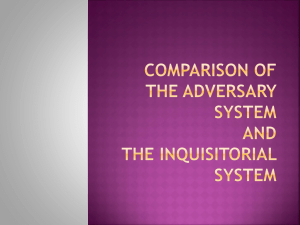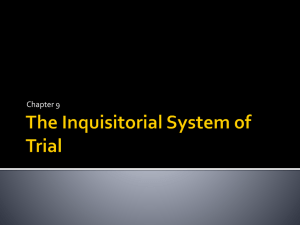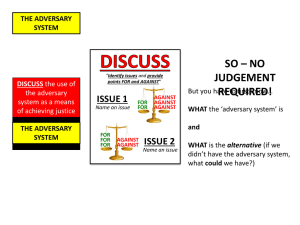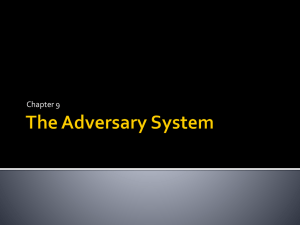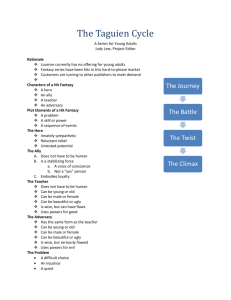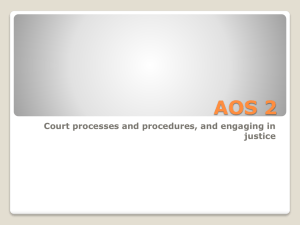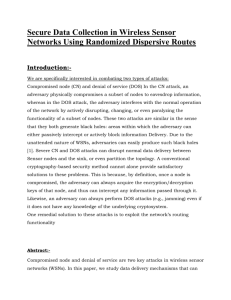adversary system
advertisement
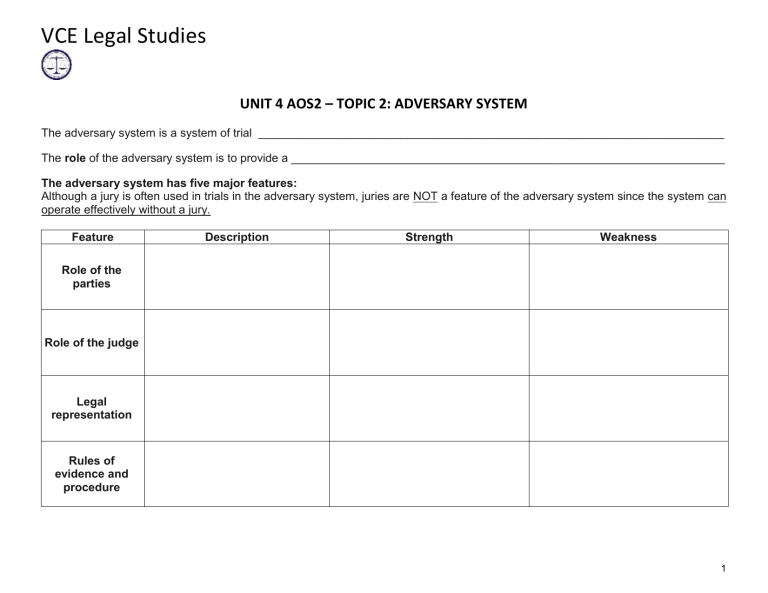
VCE Legal Studies UNIT 4 AOS2 – TOPIC 2: ADVERSARY SYSTEM The adversary system is a system of trial ________________________________________________________________________ The role of the adversary system is to provide a ___________________________________________________________________ The adversary system has five major features: Although a jury is often used in trials in the adversary system, juries are NOT a feature of the adversary system since the system can operate effectively without a jury. Feature Description Strength Weakness Role of the parties Role of the judge Legal representation Rules of evidence and procedure 1 Burden and standard of proof 2 How do each of the features of the adversary system achieve the three key elements of an effective legal system? See MABL pg 288-290. Fair and Unbiased Hearing Access to the Legal System Timely Resolution Role of the parties Role of the judge Legal representation Rules of evidence and procedure Burden and standard of proof 3 Comparison of the Adversary and Inquisitorial Systems Adversary System Inquisitorial System Primary objective Role of the parties Role of the judge Rules of evidence and procedure Legal representation Collection of evidence Type of evidence Character evidence and past record Witnesses Burden and standard of proof 4 . . Possible Reforms to the Adversary System . . 5 UNIT 4 AOS2 – TOPIC 2 – PAST EXAM QUESTIONS ‘Every person in Victoria can be confident that, if he or she should face trial in Victoria, the trial will be conducted with impartiality, fairness and independence.’ Referring to the above statement, explain two features of the adversary system of trial. 2012, Question 7 (4 marks) Task Word Content Time Explain two features of the adversary system of trial and compare them with the inquisitorial system of trial. 2009, Question 8b (6 marks) Task Word Content Time Compare one major feature of the adversary system of trial with one feature of the inquisitorial system. Would the adversary system be improved if it adopted that feature of the inquisitorial system? Justify your answer. 2007, Question 10 (6 marks) Task Word Content Time 6 ‘The use of the adversary and jury systems in Victorian criminal trials ensures that we have an effective legal system.’ Discuss the above statement and indicate the extent to which you agree with it, giving reasons for your answer. Include in your answer an explanation of two elements of an effective legal system. 2008, Question 11a (10 marks) Task Word Content Time A Supreme Court Justice recently declared that the adversary system of trial should no longer be used in Victoria. Critically evaluate the use of the adversary system of trial. In your answer describe one possible improvement to the adversary system. 2010, Question 11 (10 marks) Task Word Content Time Discuss the extent to which the adversary system achieves one of the elements of an effective legal system. In your answer, compare two features of the adversary system with the inquisitorial system. 2013, Question 13 (10 marks) Task Word Content Time 7 Report extent in their ability to make law; however, they have methods or techniques to be able to manoeuvre around these limitations. Reasons were then provided as to how judges are limited, and what techniques they could use to still make law. *** The following is in an example a good answer. ‘Every person Victoriaofcan be confident that, if he or she should face trial in Victoria, the trial will be conducted with impartiality, fairness and independence.’ Although judges can make law, they are limited in their ability to a certain extent. Courts are limited in their ability to make law because they act ex-post facto. This means that courts cannot make a law until a case comes before them. Therefore, they cannot Referring towhenever the above explain two features of the adversary system of trial. make laws theystatement, want (unlike parliament). 2012, Question (4legal marks) Courts are also limited because they are bound by precedents made by higher courts in the same court hierarchy where7the principles within similar circumstances. Therefore, if a binding precedent exists, courts do not have any ability to change the law and must abide by it. Courts are often also limited because judges can be very conservative and reluctant to change a bad law. Courts also cannot seek public opinion or consult committees before making a decision. This question was generally well done. Many students were able to explain two features of the adversary system this, however, courts do have some ability to make law. Judges are not ‘ elected’ by the people and are therefore free to withDespite reference to the given statement. The more commonly used features were the role of the judge, and the rules make decisions and not be influenced or pressured by consequences of not being re-elected if they make an unpopular ruling. of evidence and However, students couldfollowing have used any of the fivemethod features the adversary Further, judges procedure. have some flexibility in being able to avoid precedent. A common is toof distinguish the factssystem of of trial, identified thethestudy theisrole of the judge,thereby the role parties, thedifferent need tofor the case before theminfrom facts indesign the caseas which a binding precedent, beingof freethe to make a ruling thelegal binding precedent. Another common methodof is to disapprove a decision made in a of higher court, therefore opening the door for representation, the burden and standard proof, and the need for rules evidence and procedure. that case to be overruled in a future case in a higher court. Some students referred to the jury system as a feature of the adversary system; however, the jury system is not a Overall, courts do have the ability to make laws, but are limited to some extent. feature and is a separate system. Question 8a. Weaker students made no reference to the given statement. Marks 0 1 2 Average 1.3 21 of a good 56 answer. The % following 24 is an example Any of the following processes was acceptable: first reading: the long title is read, putthe on parties. the agenda andadversary copies of the Bill are circulated One •feature of the adversary system is the the Bill roleisof The system adopts a process whereby • second reading: compatibility with the Charter of Human Rights and Responsibilities, the purpose the Bill is or each party has complete control of their own case and decides which evidence to use whenofdefending outlined, the explanatory memorandum is presented, debating commences and a vote is taken prosecuting the case. This supports the idea of independence – it means that the court is not involved at all in consideration in detail each in detail once thethe speaker and amendments how •a case is conducted and (optional): is left up to theclause partyistodiscussed decide how to present case. leaves This also supports the idea can be made of fairness because it means that every party is on a ‘level playing field’ in terms of choosing how to go about • third reading: the house will formally accept or rejected the Bill, may be further debate, vote the case. • certification: the Bill is certified by the Clerk of Parliaments after it has passed through both houses • royal assent:ofpresented to the Governor-General assent/signing Another feature the adversary system is the rolefor ofroyal the judge. The judge in an adversary trial is required to • proclamation: comes into effect on a day stated in the Act or on the way Governor-General (if act impartially, as an unbiased independent umpire who does nota day get proclaimed involved inbythe the parties present neither, 28 days after royal assent). their case. This supports the idea of independence (as the judge takes no sides), fairness (as it means that the parties are being ‘umpired’ and are bound by the same rules) and impartiality (as there is no biased umpire). The legislative process of a Bill through parliament is a fundamental part of Unit 3, Area of Study 1, and students must be familiar with the various steps, as well as be able to explain what happens in each step. *** Weaker answers identified a process but were unable to provide enough detail as to what happens in the process in Explain twofull features the assent adversary system of trialresponse, and compare with thedidinquisitorial system order to gain marks. of Royal was the most popular though them some students not explain what royalof trial. assent is – the process of the Queen’s representative signing the Bill. The second reading stage was also very popular, but again some students were not able to describe what happens in this process. 2009, Question 8b (6 marks) Question 8b. Marks 0 1 2 3 4 5 6 Average % 3.6 15 5 10 13 17 18 23 Features of the adversary system which needed to be explained then compared were: • the roleadversary of the parties Features of the system which needed to be explained, then compared were: • the role of the judge • the the role need of forthe legal representation 1. parties • the rules of evidence and procedure 2. role of the judge • the standard burdenrepresentation of proof. 3. need and for legal 4. rules of evidence and procedure 5. standard and burden of proof. Legal Studies GA 3 Exam Published: 9 March 2010 7 8 Report Following are some of the points that could have been made in response to this question. This question was generally handled well, with many students showing good knowledge of the features of the Strengths system of trial. Some students struggled to compare their chosen features with those of the adversary • Parliament inquisitorial system.can investigate the whole topic and make a comprehensive set of laws. • Parliament has access to expert information and is therefore better able to keep up with changes in society. Parliament providesby ansaying arena for debate. Some• students responded that the jury system is a feature of the adversary system of trial. The study • specifically Parliament can its power to make lawadversary to expert bodies. design listsdelegate the major features of the system and students should be familiar with these • Parliament is able to involve law-making. features. Jury system is not listed asthea public featureinof the adversary system. Another common error made by students • Parliament can inquisitorial change the law as the the needdefendant arises was stating that in the system is ‘guilty until proven innocent’. • Parliament can make law in futuro. • Parliament democratically elected. This means that, in theory, its members reflect the feelings, attitudes and The following is anisexample of a good answer. values of the community. Members eventually face re-election, and this is an incentive to ensure that they continue to adversary reflect the community’s views and role do not an unaccountable One feature of the system of trial is the ofact theinjudge. The judge manner. generally acts as an independent and impartial adjudicator, ensuring that the parties adhere to the rules of evidence and procedure. A judge will Weaknesses not become involved in what evidence is brought before the court. In contrast, in the inquisitorial system, the • Investigation and implementation of new laws is time consuming and parliament is not always able to keep up judge(s) play an active role, taking part in the investigation, the questioning of witnesses as well as generally with changes in society. running the trial, collecting the evidence and ultimately reaching a verdict. • Members of parliament might be more influenced by political considerations, rather than the community good, when considering what attitude to adopt towards a Bill. Another feature is the rules of evidence and procedure. In the adversary system, witnesses must only answer the • The process of passing a Bill is time consuming. questions put to them by the lawyers/barristers. There are strict rules relating to evidence involving hearsay, • Delegated authorities are not all elected by the people and there may be too many bodies making laws. character andpossible past convictions in law criminal trials. In thechanging inquisitorial the orrules of evidence and • It evidence is not always to change the in accordance with valuessystem in society, to reach a procedure are more relaxed. Witnesses can recount their own version of events and hearsay evidence is compromise where there are conflicting values in society. permitted. In this way the inquisitorial system seems to be more in search of the truth by letting the witnesses recount their version, contrast the adversary system’s strict rules. Following is an extract in thatreal examines onetostrength of parliament as a law-maker. One strength of parliament as a law-maker is that it is able to*** delegate some of its law-making powers to expert bodies such as statutory corporations. This delegation of power saves Parliament time as well as ensuring that laws are made by those with particular expertise an area. However, some people argue thatof by trial delegating powers is allowingsystem. Compare one majorin feature of the adversary system withlaw-making one feature ofParliament the inquisitorial unelected bodies make laws. Although this is true, most bodies that make delegated legislation are not elected (with the exception Would the adversary system be improved if it adopted that feature of the inquisitorial system? Justify of local councils), nevertheless, Parliament scrutinises the whole process of delegation as well as ensuring that delegated yourlegislation answer.is reviewed, this ensures that Parliament remains representative of the people’ s views and values and responsible for the laws that are made. 2007, Question 10 (6 marks) Question 10 Marks 0 1 2 3 4 5 6 Average 18 5 9 14 19 20 15 % 3.3 Students had a good knowledge of the key features of the adversarial process of dispute resolution. The most popular feature discussed was the role of theof judge. Students had a good knowledge the key features of the adversarial process of dispute resolution. The most popular feature discussed was the role of the judge. Many students argued that the jury is a key feature of the adversary system; however, this is not case – most cases are determined without a jurythat in our resolution. A few studentssystem; did not answer the second this – most Many students argued thesystem jury isofadispute key feature of the adversary however, this ispart notofcase question, which required them to discuss whether the adversary system would be improved by adopting a feature of the the cases are determined without a jury in our system of dispute resolution. A few students did not answer inquisitorial system. It is important for students to read questions carefully and check that they have met the demands of by second part of this question, which required them to discuss whether the adversary system would be improved the question. adopting a feature of the inquisitorial system. It is important for students to read questions carefully and check that they have met the demands of the question. The following information could have been used to answer this question. The details of the inquisitorial system vary from country to country, but the general features are outlined below. The following information could have been used to answer this question. The details of the inquisitorial system vary fromofcountry to country, Features the adversary systembut the general features are outlined below. • The role of the parties: Each party is responsible for presenting their case. This means the parties decide which Featuresfactual of theand adversary system legal issues should be raised and what evidence should be presented to prove the alleged facts. Through process, the system assumes that the stronger case will emerge, and that is likely to reveal what The role this of the parties: happened. o Each party is responsible for presenting their case. This means the parties decide which • The role offactual the judge: judge is an should impartial ensures the trialshould is conducted in accordance withthe andThe legal issues bearbitrator, raised and whatthat evidence be presented to prove the rules of evidence and procedure and is not involved in the presentation of evidence or the crossalleged facts. Through this process, the system assumes that the stronger case will emerge, and examination of witnesses. that is likely to reveal what happened. The role of the judge: Legal Studies GA 3 Exam Published: 8 April 2008 5 9 2008 o ent The judge is an impartial arbitrator, ensures that the trial is conducted in accordance with the Assessm rules of evidence and procedure and is not involved in the presentation of evidence or the crossReportexamination of witnesses. Strict rules of evidence and procedure: impeded by the doctrine. Unfortunately, many students simply listed the key points without explaining how they Thesechange ensurein that only relevant and reliable evidence is presented; the same rules apply to each contribute to o or inhibit the law. party to ensure that the parties have the same opportunity to present their case. The trial is a single continuous event based The main points showing that change is possible are:on the presentation of oral evidence which is subject to crossexamination. • the courts can change a law quickly if a relevant case is brought before them the doctrine of burden precedent • Standard and of allows proof:for some flexibility. The law can be expressed as a general principle (for example, the ‘neighbour test’) allowing the courts to adapt the law to fit the circumstances before the court. o The burden of proof is on the party making the allegation. The standard of proof is beyond • courts can fill the gaps in the law by making a decision on a matter when it arises reasonable doubt in a criminal case and on the balance of probabilities in a civil case. The party • the law is prevented from being too rigid by distinguishing, overruling and reversing previous decisions with the burden of proof wins the case if they are able to satisfy the standard of proof. • judicial decisions are free from outside pressure • The need foroflegal representation: the doctrine precedent limits the possibility of prejudices or bias influencing judicial decisions • the appeals allows review of decisions o Theprocess emphasis onfor thethe presentation of the case being in the hands of the parties means that there is • if a partyahas a valid point regarding the law,The the complexity appeal process for the highest court, the High to need for legal representation. of allows the evidence and procedures makeCourt, it difficult change the as it istonot bound by any precedent.to present their case without legal representation. Success forlaw a party have a full opportunity can be influenced greatly by the skill of the legal team. The main points showing that change is inhibited by the doctrine are: Features of the inquisitorial system • courts may be bound by an old precedent, which could lead to unjust results • The more activeand than thebeadversary and is involved in decisions about somejudge judgesisaremuch very conservative could reluctant tosystem change judge, bad laws evidence is towhat be presented, the legal issues raisedbefore at thethe trial and the examination of witnesses. • which courts cannot determine the law is unless a case is brought court • • • changes in the law are ex poste facto determining the lawof this way may in be the too expensive for the involved The involvement the judge presentation of parties evidence means that, in contrast to the adversary judges are not thenot people are notover required to reflect changing piece attitudes values.is presented or a system, theelected partiesbydo haveand control whether a particular of and evidence particular witness is called. The parties cannot prevent evidence being called which is damaging to The following is an example of a good answer. This answer presented a clear point of view in the introduction and used their case. the points to look critically at the capacity of the doctrine to allow for change in the law. The answer went on to discuss The strict rules of and evidence procedure do not For example, court can case, consider howthe doctrine both allows restrictsand change. Examples, suchapply. as Menhennitt’s rulingthe in Davidson’s were hearsay evidence, and evidence gathered the to trial. This sort of evidence is not subject to crossused in the answer to illustrate the way courts havebefore contributed law-making. examination. The of precedent operates on the of principle of stare decisis (to stand by The what is decided). This principle ensures until it is doctrine The hearing takes the form an enquiry into the truth. court conducts the enquiry consistency and predictability but fundamentally works against courts changing the law. This means that the doctrine does satisfied that it has found the truth. Under the adversary system, the court’s function is not to limit find the the courts as law-makers, however, there is no doubt that some of our most controversial areas of law have been made by the truth, but to determine whether the party with the stronger case has met the standard of proof. courts, thus showing that the doctrine of precedent does allow for change in the law. The heart of the doctrine of precedent is the ‘ ratio decidendi’ , *** or reason for the decision given by the judge in a superior court. This ratio is binding on lower courts in the same hierarchy where the case being decided is so similar in facts that there can be nouse distinguishing if the judgeand does not think that thein precedent shouldcriminal be followed. This ensures idea of being ‘ bound’ by previous ‘The of the adversary jury systems Victorian trials that we have an effective decisions allows for consistency and reduces the likelihood of judges changing the law. However, judges who are bound by legal system.’ decisions may still be able to change the law by distinguishing their case from the binding one. This allows a judge to make a new precedent and thus allows for development or change in the area of law. Discuss the above statement and indicate the extent to which you agree with it, giving reasons for your QuestionInclude 11a. answer. in your answer an explanation of two elements of an effective legal system. Question chosen % Marks 0 1 None a. b. 4 43 53 2 3 4 2008, Question 11a (10 marks) 5 6 7 8 9 10 Average % 5.4 8 5 7 8 9 11 13 12 11 7 9 There were many excellent answers to this question and the structure of these responses was very pleasing. Students generally explained the powers divided andtothen the difficulty changinglegal this division An the This question gavehow students the are opportunity usediscussed two elements of an ofeffective systemoftopower. discuss area that requires some further work is in ‘specific’ powers, as students neglected to mention specified or benefits and weaknesses of the adversary and jury systems. Onceoften again there were some the excellent answers that enumerated powers of s. 51. used key knowledge to present a thorough point of view about the capacity of our adversary and jury systems to contribute to an effective legal system. Following are the key points to mention about the division of power. Most students discussed the capacity of these systems to provide fair and unbiased hearings and the recognition • Specific or enumerated powers – all powers of the Commonwealth Parliament (most are listed in s. 51 of the Constitution) and they can be: o exclusive powers – law-making powers that are not shared with the states (s. 52) 10 of prevailing values and basic human rights. Some students discussed the merits of the inquisitorial system at great length and their answer strayed from the major focus of the question. It is important that students make good judgments about what material is relevant and do not simply use everything they know. The following relevant points could have provided the basis for an answer to this question. Adversary system The system is historical, tested over time and the community has confidence in the system. Individuals are responsible for the conduct of their own cases and control their own case, making it fair and just. Rules of evidence and procedure are that both parties have equal footing. Those directly affected by the case bear the costs involved. As individuals are responsible for presenting the best case to support their point of view, all relevant evidence will be presented. The judge is believed to be independent and impartial, thus people are treated fairly/the judge is considered an independent umpire. The trial is heard in one continuous hearing so continuity of the hearing is ensured. Parties can have legal representation/legal aid. There is an emphasis on oral evidence and the examination of witnesses allows witness statements to be tested to reach the truth and achieve a fair hearing. There are rules of evidence which aim to exclude unreliable or irrelevant evidence (for example, hearsay, illegally obtained evidence, prior convictions). The parties are in charge of the presentation of the case, including gathering evidence, presentation and cross- examination in court, arguing legal points and addressing the jury. Accordingly, the success of the case can depend on the skills of a party’s legal team, particularly the advocate in court. If one party is not as well- represented as the other it will be at a disadvantage and this will introduce an element of unfairness. Good legal representation is expensive and funds for legal aid are limited, particularly where minor offences are involved. An unrepresented party is at a considerable disadvantage. As the parties control the presentation of the case, one party might chose not to present relevant evidence, or not to raise particular legal issues, because it would be damaging for that party’s case. This is in contrast with the inquisitorial system, where the judge can initiate the calling of evidence and the raising of issues. The adversarial system aims to determine which party has the stronger case. However, for all the above reasons, it might not discover the truth. Jury system Decisions reflect the views of the common person/community. Juries are independent and impartial. Juries are a cross-section of the community and reflect prevailing community attitudes. The jury system ensures that the law/the system remains intelligible to the ordinary person and involves the community. Decision-making is spread across a number of people. There is less likelihood of a wrong decision being handed down. The system provides a trial which is free from political interference. Juries can act as a social conscience. The system ensures that the hearing of evidence is conducted in an open forum. 11 2010 Assessm The jury system ent has stood the ‘test of time’ and has historical significance. Jury deliberations are kept secret and reasons do not have to be given. Report Juries may not be a true cross-section of the community, as people are able to be excused for a good reason Points that have beenof made aboutpeople whether jury system be retained, depending on the stance taken by andcould the inclusion certain onthe a jury can beshould challenged. the student, included: A jury can add to the cost and length of a trial. • jury decisions reflect the views of the common person/community •There is doubt as to whether juries understand, and recall, evidence that can be complex and technical. juries are independent and impartial juries arebe a cross-section of the community andthose reflect prevailing community attitudes rhetoric of counsel). •Jurors may influenced by facts other than put before them (for example, • ensures laws/the legal system remains intelligible to the ordinary person and involves the community Juries have been criticised because of their high acquittal rate. • decision making is spread across a number of people •Juries often difficulty reaching a decision, evendown though majority verdicts have been introduced in there is lesshave likelihood of a wrong decision being handed all cases murder treason. •Victoria providesin a trial whichbut is free from and political interference • juries can act as a social conscience ensures is thean hearing of evidence is conducted in an open forumwent on to explain how the adversary and jury The •following example of a better answer. The answer • it has stood the ‘test of time’ and has historical significance systems contribute to the reflection of values and rights. It also discussed the extent to which this was prevented • jury deliberations are kept secretbiases and reasons for their decision dofor notlegal have to be given by things such as a jury’s inherent and the requirement counsel to successfully navigate the • juries may not be a true cross-section of the community as people are able to be challenged and excused for a adversarial processes. good reason • a jury can add to the cost and length of a trial The adversary system and jury system in Victorian criminal trials generally do contribute to an effective legal • do juries understand, and recall, evidence that can be complex and technical? system by allowing for fair and unbiased hearings and reflecting prevailing values and basic human rights. • jurors may be influenced by things other than the facts before them; for example, the rhetoric of counsel However, there are some aspects of each of these systems that reduce their capacity to achieve these elements of • juries have been criticised because of their high acquittal rate an effective legal system. • difficulty reaching a decision, even though majority verdicts have been introduced in Victoria in all cases bar murder and treason. The adversary system allows for fair and unbiased hearings by ensuring that the adjudicator or judge is an impartial third party who was doesgenerally not participate collection or presentation evidence. The first part of this question well donein bythe many students. Students needed toof make a coupleParties of pointscall their own regulated rules of evidence andthe procedure, and each has equal The opportunity to aboutevidence, the jury’s role in orderby to strict gain full marks, including that jury deliberates on theparty guilt of thean accused. second part students whether or nottheir they case supported juries in Victoria – whetherjudge they thought present the asked best evidence to support and the retention verdict isofdecided by an impartial or a group of 12 juries should stay and forofwhat It waswho evident thatupsome students did not knowthe the complexity meaning of ‘retention’, independent members thereasons. community make a jury. Unfortunately, of the strict rules of thinking it meant to abolish juries. Weaker students seemed to use pre-prepared answers and beganThis discussing evidence and procedure mean that legal counsel is required to understand these rules. meanspossible that it is very reforms or to alternatives to the system, whichprevent was notsome what the question No access marks were awarded for expensive take a case tojury court and may people fromasked. having to this fair method of dispute discussions about reforms or alternatives to the jury system. resolution. It is important that students organise their responses well. Responses to this question should have included a paragraph about the role of the criminal jury, followed by a statement as*** to whether or not the student supported the retention of A Supreme Court Justice recently declared that the adversary of the trial shouldorno longerofbe used in juries, then a paragraph for each of their reasons. Students could have eithersystem supported retention abolition Victoria. juries. Many students stated that they supported the retention of juries but acknowledged some of its weaknesses; this was appropriate as long as the question was answered and detailed reasons were provided. Critically evaluate the use of the adversary system of trial. In your answer describe one possible Question 11 to the adversary system. improvement Question chosen % Marks % 0 10 none a. b. 4 53 43 1 6 2 8 3 8 4 10 2010, Question 11 (10 marks) 5 10 6 11 7 11 8 10 9 8 10 8 Average 5.1 The following points could have been made about the adversary system of trial. Question 11a. The following points could have been made about parliament as a law-maker. Strengths of the adversary system Strengths of parliament The system is historical, tested over time and the community has confidence in the system. • can investigate the whole topic and make a comprehensive set of laws Individuals are responsible for the conduct of their own cases/control their own case – fair and just. • has access to expert information and is therefore better able to keep up with changes in society • Rules of an evidence procedure – both parties have equal footing. provides arena forand debate can delegate its power to make law to expert bodies • Those directly affected by the case bear the costs involved. • is able to involve the public in law-making As individuals are responsible for presenting the best case to support their point of view, all relevant • can change the law as the need arises evidence will be presented. • • can make law in future is democratically elected. Weaknesses of parliament 12 There is the belief that the judge is independent and impartial, thus people treated fairly/independent umpire. The trial is heard in one continuing hearing, so continuity of the hearing is ensured. Parties can have legal representation/legal aid. There is an emphasis on oral evidence and the examination of witnesses allows witness statements to be tested to reach the truth and achieve a fair hearing. Standard and burden of proof – an accused is considered innocent until proven guilty in a criminal trial. Weaknesses of the adversary system The parties are in charge of presentation of the case, including gathering evidence, presentation and cross- examination in court, arguing legal points and their address to the jury. Accordingly, the success of the case can depend to a good deal on the skills of a party’s legal team, particularly the advocate in court. Where one side is not as well represented as the other, that party will be at a disadvantage, and this will introduce an element of unfairness. Good legal representation is expensive, and funds for legal aid are limited, particularly where minor offences are involved. An unrepresented party is at a considerable disadvantage. As control of the presentation of the case is in the hands of the parties, one party might chose not to present relevant evidence, or not to raise particular legal issues, because it would be damaging for that party’s case. Contrast with the inquisitorial system where the judge can initiate the calling of evidence and the raising of issues. The adversarial system aims to determine which party has the stronger case. However, for all of the reasons listed above, it might not discover the truth. Possible improvements to the adversary system of trial include: increased judicial involvement in proceedings simplification of the rules of evidence and procedure, generally or with specific examples encouragement of alternative methods of dispute resolution greater control over legal costs increased availability of legal aid to facilitate improved access to legal representation increased spending on the legal system (for example, more courts and judges). It was evident that many students need to work on their skills of critically evaluating and practise this skill in examination conditions in the classroom. A critical evaluation required a detailed consideration of strengths and weaknesses, with a conclusion as to the value or worth of the adversary legal system. Stronger students provided a good description of the strengths and weaknesses of the adversary system, coming to a conclusion as to whether it is a good or bad system or whether it needs improvement. The possible improvement was better addressed after a weakness was described or at the end of the answer. Other strong students used each of the five features of the adversary system to begin their paragraphs and discussed strengths and weaknesses of each. It was not necessary to give detail of the strengths and weaknesses of all of the five features to gain full marks; however, the more successful responses discussed at least three of these features. Weaker students saw this as a question about a comparison with the inquisitorial system. Although the inquisitorial system could have been used in a discussion about the weaknesses or improvements to the adversary system, it was not necessary to score high marks. For the improvement, students needed to explain how that recommendation or suggestion would improve the adversary system; this could be done by explaining how it would address a certain weakness or perhaps how it 13 may achieve one of the elements of an effective legal system. Some weaker responses incorrectly referred to the jury system or pre-trial procedures, such as committal hearings, as features of the adversary system of trial. Features of the adversary system of trial are described in the study design. The following is an example of a good beginning to a response. There are five features of the adversary system of trial, and each of these features have both strengths and weaknesses. One of the strengths of the role of the parties is the total control given to the parties to run their case. That means that the parties decide which evidence they are to call and how they will run their case, therefore ensuring they take responsibility of the case. However, this can lend itself to being a weakness as it means they can exclude certain witnesses from trial, or some unrepresented parties may not have a good handle of their case, thus causing the possibility of there not being a fair hearing. The passive and impartial role of the judge is a strength because it ensures he or she is unbiased and does not take any sides, acting as a referee only and ensuring rules of evidence and procedure are followed. This, however, could be a weakness as the judge is the most experienced and specialised person in the trial room which is unutilised and hinders the possibility of a fairer trial should one party be on less of an equal footing than another party. One improvement that could be made to the adversary system is to increase the role of the judge in pre-trial procedures such as directions hearings. Judges could provide more guidance to parties about evidence to lead or law to be considered, thus ensuring a more fair outcome is achieved and that parties can be prepared for trial on a more equal footing. *** Discuss the extent to which the adversary system achieves one of the elements of an effective legal system. In your answer, compare two features of the adversary system with the inquisitorial system. 2013, Question 13 (10 marks) There were two parts to this question. The first asked for a discussion about the extent to which the adversary system achieved one of the elements of an effective legal system. The second asked for a comparison of two features of the adversary system with the inquisitorial system. Many students did not correctly identify the features of the adversary system. The jury system and the court hierarchy, for example, are not features of that system. The features of the adversary system are: the role of the judge, the role of the parties, the need for legal representation, the burden and standard of proof, and the rules of evidence and procedure. Many responses were too vague about either the adversary system or the inquisitorial system. For example, there seems to be an incorrect assumption that the inquisitorial system maintains the principle that an accused is ‘guilty until proven innocent’. This is not correct. Furthermore, many students argued that the judge’s role in the inquisitorial system is far greater than what it is, suggesting that the judge becomes involved and active in every case (in most cases, the judge is not involved in investigations, which are largely conducted by law-enforcement agencies). High-scoring responses used appropriate features to address whether or not the chosen element of an effective legal system was achieved, following through with a consideration of the similarities and differences of those two features with the inquisitorial system. Weaker students merely listed and described the five features without 14 any discussion or comparison. The number of points that a student could have made is extensive and depends on the element chosen. Therefore, not all points are addressed here. The following are some of the more popular points that were made. fair and unbiased hearing o party control – ensures fairness by allowing parties to direct the conduct of the case, not the judge; however, this means that some evidence may not be led or less weight is given to certain evidence o rules of evidence and procedure – ensures both parties are subjected to the same rules; however, often, the rules of evidence and procedure are strict, disallowing evidence that may be helpful, thus impacting on the fairness of an outcome not necessarily decided by consideration of all evidence o role of the judge – independent and unbiased, issues of bias can be appealed o legal representation – often, the outcome may depend on the experience or credibility of legal representation, which may be seen as unfair access to the legal system o legal representation – all parties have an equal right to legal representation and some can get access to legal aid; however, some parties cannot afford legal representation or may only be able to afford legal representation that is less experienced than another party’s o role of the judge – at any time, the judge can direct the parties to attend mediation, which can help reduce costs and time; however, the judge is unable to get involved in the case, therefore limiting a person’s access to the judge’s expertise o rules of evidence and procedure – ensures that each party has a right to present the case; however, due to the complexity of the rules, it limits a person’s ability, particularly an unrepresented person, to effectively access the system timely resolution o role of the judge – the judge can make directions and orders during the course of the trial and during o pre-trial proceedings, which reduces the time it takes for a case to be heard – note in particular the enhanced powers of the judge by virtue of the Civil Procedure Act 2010 (Vic.); however, the judge’s broad powers may not be used and the judge may take a more traditional, passive role in the case, thus increasing the length of the trial o legal representation – the use of legal representation can reduce the time taken to explain procedures and/or rules to unrepresented parties o parties can choose which witnesses to call and what evidence to rely on, which can reduce the time it takes for a hearing to take place; however, the reliance on oral evidence increases the time it takes for a matter to be heard and, also, as parties have control over what evidence to call, this could delay the trial if the evidence is extensive The more common comparison points used were those regarding the role of the judge, the role of the parties and the involvement of legal representation. Features of the inquisitorial system that could have been used as a point of comparison include the following. The role of the parties is greatly reduced given the role of the judge. Often, the parties are not required to attend court in civil proceedings. The parties are required to respond to the court’s directions. The judge in this system has a far greater role than in the adversary system and can investigate and question witnesses. The examining judge does not sit on the trial court (in some systems, the trial court is held in a similar manner to the adversary trial). Similar to the adversary system, the legal practitioner can question witnesses. Rules of evidence and procedure are not as strict as those in the adversary system. There is an extensive use of written evidence and witnesses are free to tell their story. 15 The judge will determine whether the evidence is relevant and reliable (similar to the adversary system). 16
